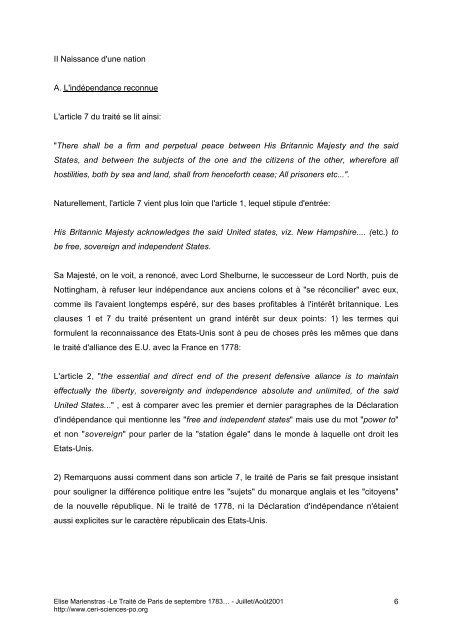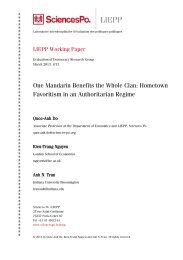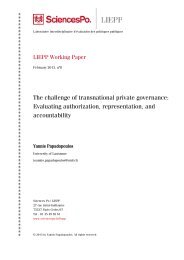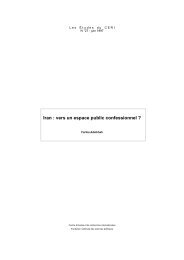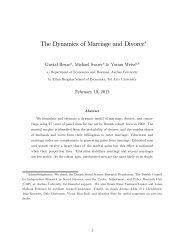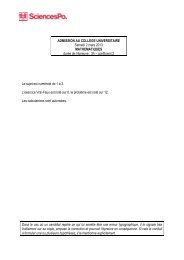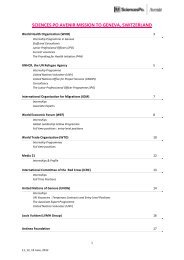II Naissance d'une nationA. L'indépendance reconnueL'article 7 du traité se lit ainsi:"There shall be a firm and perpetual peace between His Britannic Majesty and the saidStates, and between the subjects of the one and the citizens of the other, wherefore allhostilities, both by sea and land, shall from henceforth cease; All prisoners etc...".Naturellement, l'article 7 vient plus loin que l'article 1, lequel stipule d'entrée:His Britannic Majesty acknowledges the said United states, viz. New Hampshire.... (etc.) tobe free, sovereign and in<strong>de</strong>pen<strong>de</strong>nt States.Sa Majesté, on le voit, a renoncé, avec Lord Shelburne, le successeur <strong>de</strong> Lord North, puis <strong>de</strong>Nottingham, à refuser leur indépendance aux anciens colons et à "se réconcilier" avec eux,comme ils l'avaient longtemps espéré, sur <strong>de</strong>s bases profitables à l'intérêt britannique. <strong>Le</strong>sclauses 1 et 7 du traité présentent un grand intérêt sur <strong>de</strong>ux points: 1) les termes quiformulent la reconnaissance <strong>de</strong>s Etats-Unis sont à peu <strong>de</strong> choses près les mêmes que dansle traité d'alliance <strong>de</strong>s E.U. avec la France en 1778:L'article 2, "the essential and direct end of the present <strong>de</strong>fensive aliance is to maintaineffectually the liberty, sovereignty and in<strong>de</strong>pen<strong>de</strong>nce absolute and unlimited, of the saidUnited States..." , est à comparer avec les premier et <strong>de</strong>rnier paragraphes <strong>de</strong> la Déclarationd'indépendance qui mentionne les "free and in<strong>de</strong>pen<strong>de</strong>nt states" mais use du mot "power to"et non "sovereign" pour parler <strong>de</strong> la "station égale" dans le mon<strong>de</strong> à laquelle ont droit lesEtats-Unis.2) Remarquons aussi comment dans son article 7, le traité <strong>de</strong> <strong>Paris</strong> se fait presque insistantpour souligner la différence politique entre les "sujets" du monarque anglais et les "citoyens"<strong>de</strong> la nouvelle république. Ni le traité <strong>de</strong> 1778, ni la Déclaration d'indépendance n'étaientaussi explicites sur le caractère républicain <strong>de</strong>s Etats-Unis.Elise Marienstras -<strong>Le</strong> Traité <strong>de</strong> <strong>Paris</strong> <strong>de</strong> <strong>septembre</strong> <strong>1783</strong>… - Juillet/Août2001http://www.ceri-sciences-po.org6
B. La nation inachevéeRestait aux nouveaux Etats à imposer aux signataires <strong>de</strong> <strong>Paris</strong> et <strong>de</strong> Versailles les garantiescommerciales et territoriales qui restèrent volontairement dans le flou ou non mentionnéesdans le traité. Il fallait pour cela, soutinrent les Gouverneur Morris, les Alexandre Hamilton, etmaints autres "nationalistes" que les Etats-Unis s'unissent <strong>de</strong> manière plus intime et que laConstitution qui en faisait une confédération lâche et dépourvue d'un exécutif puissant soitamendée. D'où toute la campagne pour une nouvelle Constitution, dont nous n'avons pas letemps d'évoquer tous les tenants, mais qui constitue, certes, la troisième étape <strong>de</strong> la mise enplace d'un Etat-nation dont M.J.Rossignol nous dira tout à l'heure qu'elle ne suffit pourtantpas à assurer l'autorité sur la scène internationale. Ce n'est qu'avec les traités <strong>de</strong> Jay, <strong>de</strong>Pinckney, puis, après la guerre <strong>de</strong> 1811-1814 qu'on nomme parfois "<strong>de</strong>uxième guerred'indépendance" que les Etats-Unis, tout en conservant une large dépendance économiqueet commerciale à l'égard du système mercantile britannique et européen, réussiront à obtenirle respect <strong>de</strong>s clauses signées en <strong>1783</strong>.Mais même alors, l'une <strong>de</strong>s ambiguïtés majeures, mais non diplomatiques du traité, celle <strong>de</strong>la langue, subsiste pour nous rappeler que si l'Etat-nation a disposé <strong>de</strong>s instrumentsjuridiques, diplomatiques et institutionnels pour être mis au mon<strong>de</strong>, la nation proprement diterequiert encore une culture propre qui la distingue <strong>de</strong> sa mère-patrie. Des traitésinternationaux, la paix <strong>de</strong> <strong>Paris</strong> est le seul qui soit rédigé en une seule langue sur une seulecolonne. On pourrait gloser à loisir sur les lacunes culturelles <strong>de</strong> la nouvelle république, ouplutôt sur le "patrimoine" reçu <strong>de</strong> l'Angleterre <strong>de</strong> sorte que, comme l'écrivait Marcus Cunliffe,on pourrait dire que Shakespeare, Milton , la Bible du roi James peuvent être considéréscomme Américains. La question <strong>de</strong> l'indépendance culturelle <strong>de</strong>s Etats-Unis se poseraencore longtemps et n'est pas totaement résolue, du moins pour son contenu et son unicitéIII. Un traité colonialOutre le caractère non achevé, d'avenir douteux <strong>de</strong> la nation qui était reconnue avantmeême d'exister, s'amorçait, dans le non-dit du traité, une nouvelle formule coloniale (laspoliation faite par l'etat au nom <strong>de</strong>s citoyens) dont on oublie trop souvent qu'elle fut emmemêmele résultat <strong>de</strong> la première <strong>de</strong>s indépendances coloniales. Ce non-dit, il joua, non sansmal, mais à l'encontre <strong>de</strong> toutes les valeurs proclamées, en faveur <strong>de</strong> la croissance <strong>de</strong> lajeune nation dont l'avenir était inscrit sur parchemin, sinon dans les faits, dès les trois étapes<strong>de</strong> sa naissance -la déclaration <strong>de</strong> 1776 par laquelle les colons se saisissaient <strong>de</strong> lasouveraineté étatique; le traité <strong>de</strong> <strong>Paris</strong> au rterme duquel ils se trouvaient <strong>de</strong> jure à égalitéElise Marienstras -<strong>Le</strong> Traité <strong>de</strong> <strong>Paris</strong> <strong>de</strong> <strong>septembre</strong> <strong>1783</strong>… - Juillet/Août2001http://www.ceri-sciences-po.org7


